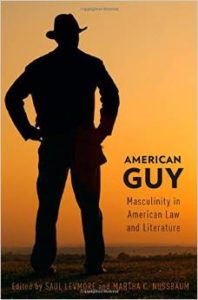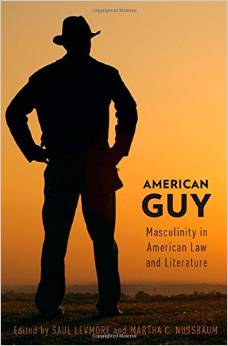Review of Martha Nussbaum and Saul Levmore’s Book on American Masculinity
 Legally Male
Legally Male
The Gay and Lesbian Review, March-April 2015
MASCULINITY is a flexible enough concept, and America is a large enough country, that the essays in this collection cannot be reduced to a single dimension or formula. American Guy, edited by Saul Levmore and Martha Nussbaum, grew out of an academic conference of the law and literature movement, a subfield of legal scholarship that examines the law in and through literature, and is the third in a series of anthologies, following a volume on Shakespeare and another on the British novel, both also co-edited by Nussbaum.
The majority of the sixteen essays are by legal experts, among them six federal judges (one retired) and five law professors. Another contributor, Paxton Williams, is an actor and playwright with a law degree from the University of Chicago Law School, where Nussbaum holds an appointment. What the essays have in common is an interest in the intersection of the concept of masculinity and matters related to the law, broadly defined (defiance of or compliance with the law, legislative processes, lawyers as social actors). Surprisingly, perhaps, these writers do not analyze masculinity in actual or historical settings. Instead, their source material is American literature, and the target of study for virtually all of these studies of masculinity is a male protagonist. (The exception is Richard Posner, who uses a Google tool to count the frequency of terms such as “masculinity” and “manhood” since 1700.)
The essays are grouped under two headings. Those under “American Guys” focus on masculinity in mainstream society. What emerges is not so much a quality or set of qualities as a tension between action and restraint, defiance and conformity, freedom and the law. Among the works surveyed are Melville’s story “Bartleby the Scrivener,” Fitzgerald’s The Great Gatsby, Hemingway’s The Old Man and the Sea, and recent fiction such as Gilead by Marilynne Robinson.
The second section, “Outsiders,” focuses on challenges to American culture from the likes of gay men and Jewish lawyers (as in Martha Nussbaum’s treatment of a Philip Roth story). Separate articles examine African-American masculinity as represented in James Baldwin’s If Beale Street Could Talk, a play by Ossie Davis, and President Obama’s autobiographies. Focusing more on society’s norms than the law, two English professors and leading scholars of GLBT studies and queer theory aim a critical dart at conventional masculinity.
In “Manning Up,” Michael Warner distinguishes between a man as a biological entity and a “real man” or “manly man” as shaped by society’s norms. The elastic label of masculinity operates in sometimes manipulative and contradictory ways. Warner cites the example of the “Man Up” campaign against domestic violence, an advocacy campaign that builds on the perception of aggression as masculine only to propose restraint as the true marker of manhood. Warner’s jargon is that of queer theory rather than the law, as when he writes about masculinity as performance: “Performances of manning up and the face work that sustains them … work best when they convince interlocutors of the possibility of standing indifferent to the need for manning up itself.” Accordingly, in its more subtle expressions, masculinity stops being a performance and reverts to the status of a natural quality, the effortless, unconscious demeanor of someone who doesn’t know enough to care about appearances. Melville’s Billy Budd presents a pure idea of manhood by being oblivious to the prevailing norms of masculinity on the ship.
David Halperin highlights and extols the stereotypically “feminine” elements of gay male culture. His essay “What is Gay Femininity?” is a friendlier restatement of the main argument in his 2012 book How To Be Gay. Gay culture’s embrace of camp, glamor, female impersonation, and æstheticism creates a new or “proxy” identity by which “gay men can assert a particular, non-standard, antisocial way of being, feeling, and behaving. It represents, more particularly, an ethos at odds with specific forms or manifestations of traditional heterosexual masculinity.” It’s all about relaxing some of the stiff standards of masculinity while maintaining a masculine identity. When gay culture was underground, and when homosexuality was perceived as antithetical to masculinity, the trappings of femininity were useful for coalescing a community of men. Today, however, when gay men’s masculinity is often accepted, gay male femininity has undoubtedly lost some of its radical flair, but by going mainstream it has allowed the rest of society to lighten up a bit.
What, then, is gay male masculinity? An answer of sorts is provided by the Fourth Circuit judge J. Harvie Wilkinson in his essay “Solitary Man in American Literature and Law.” Among the models of male solitude he proposes is “alienated solitude,” which he demonstrates with Christopher Isherwood’s 1962 novel A Single Man, whose gay protagonist George looks down on the society into which he cannot assimilate. “He projects a discriminatory attitude onto his neighbors,” writes Wilkinson, “but he also resigns himself to the role of outcast, depriving himself of access to life’s happiness and nurturing no hope of change.” In this pre-Stonewall picture of alienation, men are forced into choosing whether to succumb to society’s negative image or to adopt a superior attitude that rejects society itself. What he’s denied is the right to be a man on equal terms with the rest of society.
